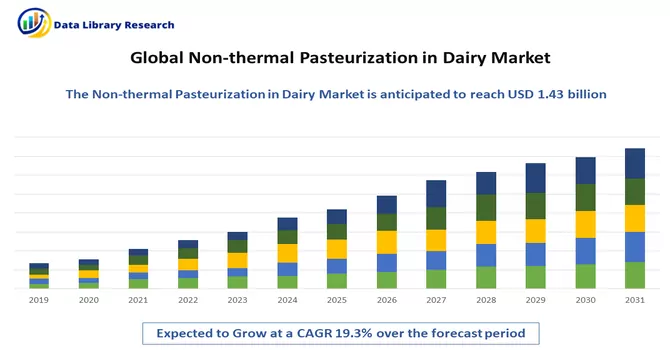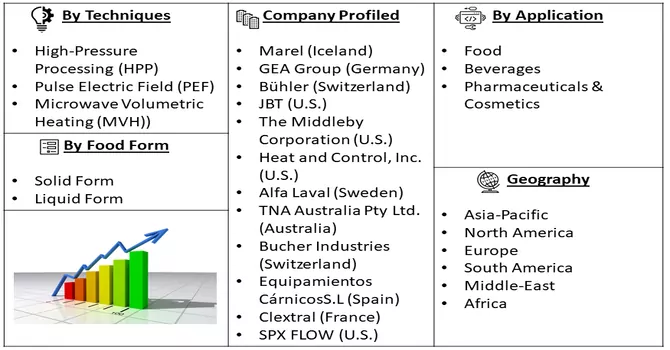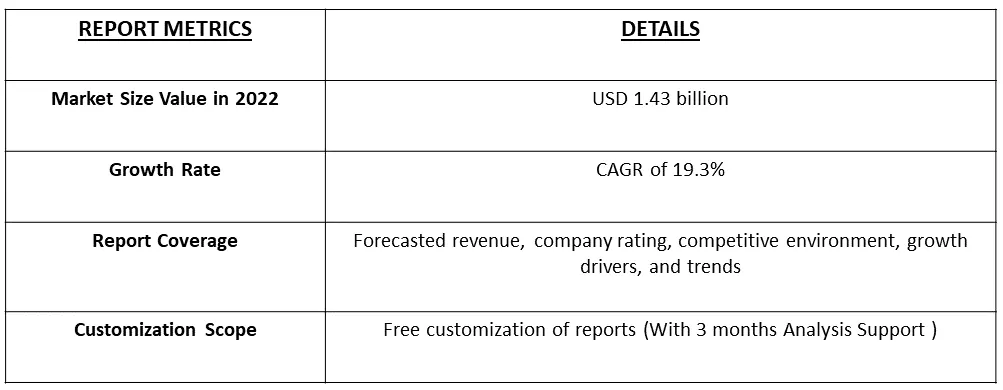The Non Thermal Pasteurization is currently valued at USD 1.43 billion in 2021 and is expected to register a CAGR of 19.3% during the forecast period, 2023-2030.

Get Complete Analysis Of The Report - Download Free Sample PDF
Global non-thermal pasteurization, also known as non-thermal processing, refers to a set of food preservation techniques that ensure the safety and shelf stability of food and beverages without relying on traditional heat-based pasteurization methods. Unlike thermal pasteurization, which involves heating foods to specific temperatures to kill or inactivate pathogens, non-thermal pasteurization methods use alternative processes to achieve the same objective without subjecting the product to high heat.
Non-thermal pasteurization techniques are applicable to a wide range of products, including dairy, juices, meat, and ready-to-eat meals. This versatility makes them attractive to a broad spectrum of food and beverage manufacturers. The continuous advancements in non-thermal pasteurization technology have improved efficiency, scalability, and affordability, making these methods more accessible to a broader range of companies.
Partnerships and collaborations between equipment manufacturers, food processors, and research institutions are driving innovation and the development of new non-thermal pasteurization technologies. Moreover, the development of standardized regulatory guidelines and industry standards for non-thermal pasteurization methods is ensuring compliance and improving consumer confidence.
Segmentation:
The Global Non-Thermal Pasteurization Market is Segmented
By Techniques :
Application :
Food Form :
Geography :
The market sizes and forecasts are provided in terms of value in USD billion for all the above segments.

For Detailed Market Segmentation - Download Free Sample PDF
Drivers:
Shift in Consumer's Lifestyle and Growing Demand from Various End Use Industries
The non-thermal pasteurization market is experiencing a significant shift driven by changes in consumer lifestyles and growing demand from various end-use industries. Consumers are increasingly health-conscious, seeking minimally processed and nutrient-dense foods. Non-thermal pasteurization methods, which retain the nutritional content and flavor of products, align with this lifestyle shift. The clean label movement, emphasizing simple and natural ingredients, is prompting manufacturers to use non-thermal pasteurization to achieve a cleaner ingredient list and meet consumer demands for transparency. Moreover, the demand for convenience foods and ready-to-eat meals is growing. Non-thermal pasteurization ensures the safety and shelf life of these products without compromising taste and texture. Thus, the market is expected to witness significant growth over the forecast period.
Ongoing Research and Development Activities and Growing Awareness of Food Safety
The non-thermal pasteurization market is experiencing a wave of transformation driven by a deepened understanding of food safety, innovation in technology, and a consumer base that seeks minimally processed, safe, and nutritious products. As research continues to advance and new technologies are developed, the non-thermal pasteurization market is poised to play an instrumental role in shaping the future of the food and beverage industry. Growing consumer education initiatives are shedding light on the advantages of non-thermal pasteurization in preserving the nutritional value and sensory quality of foods. Informed consumers are increasingly seeking products processed with these methods. Thus, the market is expected to witness significant growth over the forecast period.
Restraints :
High Capital Investment and Misinformation Leading to Additional Regulatory Steps for Labelling Irradiated Food
Non-thermal pasteurization methods often require substantial capital investment in specialized equipment and technology. The high upfront costs associated with acquiring and implementing these technologies can deter some food and beverage manufacturers, particularly small and medium-sized enterprises (SMEs), from adopting non-thermal pasteurization solutions. This capital-intensive nature of the technology can be a significant barrier to entry and expansion. Thus, the growth of the market is expected to slow down over the forecast period.
Segmental Analysis :
High-Pressure Processing (HPP) is Expected to Witness Significant Growth Over the Forecast Period
High-pressure processing (HPP) is a notable non-thermal pasteurization method that has gained prominence in the food and beverage industry. Unlike traditional pasteurization methods that use heat to eliminate harmful microorganisms and enzymes, HPP employs pressure to achieve the same objectives. The high pressure used in HPP disrupts the cellular structures of microorganisms, including bacteria, molds, and yeasts, rendering them inactive. Enzyme activity is also inhibited, which extends the shelf life of products. HPP does not expose food to high temperatures, preserving the nutritional content, color, taste, and texture of products. This is especially important for heat-sensitive substances. Thus, the segment is expected to witness significant growth over the forecast period.
Food and Beverages is Expected to Witness Significant Growth Over the Forecast Period
High-pressure processing (HPP) has become a pivotal technology in the food and beverage industry due to its numerous advantages in preserving and enhancing the quality and safety of a wide range of products. : HPP effectively eliminates harmful microorganisms, making juices and beverages safer for consumption without the need for heat pasteurization, which can degrade flavor and nutritional content. Thus, the segment is expected to witness significant growth over the forecast period.
North America Region is Expected to Witness Significant Growth Over the Forecast Period
North America is a significant and dynamic market for non-thermal pasteurization, driven by several factors that are shaping the growth and adoption of these technologies in the region. North American consumers are increasingly seeking fresh and minimally processed foods with natural flavors and nutrients intact. Non-thermal pasteurization methods, such as high-pressure processing (HPP), enable food products to maintain their freshness and nutritional value, meeting consumer demands.
The region's stringent food safety regulations and the growing importance of clean label products are driving the adoption of non-thermal pasteurization methods. Consumers are becoming more conscious of the ingredients in their food, leading to the demand for products processed with non-thermal techniques that do not involve chemical preservatives. Thus, the region is expected to witness significant growth over the forecast period.

Get Complete Analysis Of The Report - Download Free Sample PDF
The nonthermal pasteurization market competitive landscape provides details by competitor. Some of the major players operating in the nonthermal pasteurization market are:
Q1. What is the Growth Rate of the Non-thermal Pasteurization in Dairy Market?
Non-thermal Pasteurization in Dairy Market is expected to register a CAGR of 19.3% during the forecast period.
Q2. What segments are covered in the Non-thermal Pasteurization in Dairy Market Report?
By Techniques, By Application, By Food Form and Geography these segments are covered in the Non-thermal Pasteurization in Dairy Market Report.
Q3. Which region has the largest share of the Non-thermal Pasteurization in Dairy Market? What are the largest region's market size and growth rate?
North America has the largest share of the market. For detailed insights on the largest region's market size and growth rate request a sample here
Q4. Who are the key players in the Non-thermal Pasteurization in Dairy Market?
Some key players operating in the market include:
Data Library Research are conducted by industry experts who offer insight on industry structure, market segmentations technology assessment and competitive landscape (CL), and penetration, as well as on emerging trends. Their analysis is based on primary interviews (~ 80%) and secondary research (~ 20%) as well as years of professional expertise in their respective industries. Adding to this, by analysing historical trends and current market positions, our analysts predict where the market will be headed for the next five years. Furthermore, the varying trends of segment & categories geographically presented are also studied and the estimated based on the primary & secondary research.
In this particular report from the supply side Data Library Research has conducted primary surveys (interviews) with the key level executives (VP, CEO’s, Marketing Director, Business Development Manager and SOFT) of the companies that active & prominent as well as the midsized organization
FIGURE 1: DLR RESEARH PROCESS

Extensive primary research was conducted to gain a deeper insight of the market and industry performance. The analysis is based on both primary and secondary research as well as years of professional expertise in the respective industries.
In addition to analysing current and historical trends, our analysts predict where the market is headed over the next five years.
It varies by segment for these categories geographically presented in the list of market tables. Speaking about this particular report we have conducted primary surveys (interviews) with the key level executives (VP, CEO’s, Marketing Director, Business Development Manager and many more) of the major players active in the market.
Secondary ResearchSecondary research was mainly used to collect and identify information useful for the extensive, technical, market-oriented, and Friend’s study of the Global Extra Neutral Alcohol. It was also used to obtain key information about major players, market classification and segmentation according to the industry trends, geographical markets, and developments related to the market and technology perspectives. For this study, analysts have gathered information from various credible sources, such as annual reports, sec filings, journals, white papers, SOFT presentations, and company web sites.
Market Size EstimationBoth, top-down and bottom-up approaches were used to estimate and validate the size of the Global market and to estimate the size of various other dependent submarkets in the overall Extra Neutral Alcohol. The key players in the market were identified through secondary research and their market contributions in the respective geographies were determined through primary and secondary research.
Forecast Model
